
I’ve been a vocal critic of Smart Shopping campaigns.
I used to consider this fully automated Shopping campaign part of the big bag of dirty tricks Google uses to squeeze more money out of unknowing advertisers.
So for the last couple of years, I’ve steered clear of Google Smart Shopping campaigns and advised others to do the same.
But recently I’ve started to warm up to Smart Shopping. There are two reasons for that.
- I’m starting to see solid results in some situations cases.
- It’s where Google is headed. Resisting all automation because I desperately want to stay in control isn’t a very helpful attitude.
So in this article, I’ll show you what Smart Shopping campaigns are, how exactly they work and what has caused me to change my mind!
What is Google Smart Shopping?
Google Smart Shopping is a campaign subtype in Google Ads that is a mix of a normal Shopping campaign and a Dynamic Remarketing campaign.
That means your products can not only show in the search results, but also on the Display network, YouTube or in Gmail.
These could be Smart Shopping Ads:
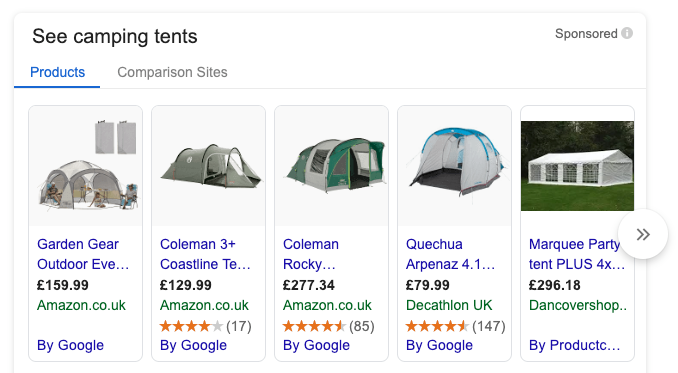
But this ALSO is a Smart Shopping Ad:
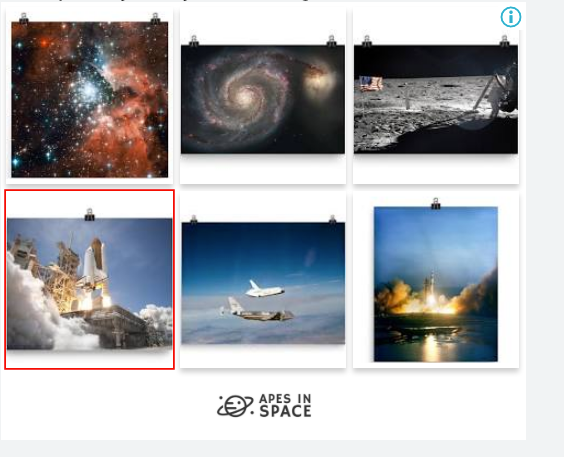
The “Smart” part indicates that Google uses automation to show the right ads to the right people in the right places.
This requires a leap of faith. Because Google doesn’t tell you which search queries your ads appeared for, or which sites your ads appeared on.
Not knowing where my ads appear or being to check the performance of these placements is already causing some unease with me.
A bigger problem is the fact that Google can choose which part of the budget to allocate to remarketing vs prospecting. Because this blends both campaign types, it makes direct comparison with other campaigns harder.
Before we get into the details of Smart Shopping, let’s look at the difference between the two Shopping campaign subtypes.
Difference between Smart Shopping and Standard Shopping
The big difference between Standard vs Smart Shopping is how much control you have as an advertiser.
With Standard Shopping, you can see the queries your ads appear for, and are able to throttle them up or down, or even exclude them as negative keywords.
With Smart Shopping, you’re giving up all that control in exchange for a wider reach and more of Google’s automation.
Comparison:
| Standard Shopping | Smart Shopping | |
| Networks where your ads appear | Search Network | Search Network, Display Network, Search Partners, YouTube, Gmail |
| Reach | Limited | Wide |
| Bid strategy | Manual and automated | Automated only (Maximize Conversion Value with optional Target ROAS) |
| Level of control | High | Low |
| Campaign transparency | High | Low |
| Optimization potential | High | Low |
| Remarketing | Optional if you add the Audiences | Included by default |
Before showing you how to create the actual campaigns, let’s tackle the big question first.
When should you use Smart Shopping campaigns?
My answer depends how experienced you are with Google Ads and Shopping in particular and whether you want to put in the time to learn and get better results.
If you’re starting out, or you’re short on time and knowledge about Google Ads, Smart Shopping isn’t a bad pick to get going and get a feel for what’s possible.
The Only Two Situations I Use Smart Shopping In
If you’re more experienced, or want to get better at Shopping, my answer is a little different.
I use Smart Shopping in two cases:
- when my regular approach doesn’t work
- to test what’s if there are any algorithm improvements
As I said in the beginning, I used to ban Smart Shopping completely from my accounts.
I wanted to keep as much control over my campaigns as I could. But there have been cases where I couldn’t figure out how to make the campaigns work. And in some of these cases? I started testing whether Smart Shopping campaigns could make a difference. And in some cases they did.
The second reason for using Smart Shopping is to stay up to date. Google is learning and improving with every click, and I’m confident that the Smart part is only going to get smarter.
So I don’t want to be left behind the day when Smart Shopping outperforms my own efforts.
Check the Results section further in this article to see a couple of examples of both situations.
How To Set Up A Smart Shopping Campaign
To get started with Smart Shopping, there are two requirements:
Smart Shopping Requirements
- Product feed uploaded and approved: you need a feed in Google Merchant Center and products need to be approved
- Conversion tracking configured: since Google is using conversions to optimize your campaigns, you need to record and send them into Google Ads.
- Remarketing list with 100 users: if you have added the Global Site Tag to your site (this is the same as the Google Analytics tracking code), you need at least 100 visitors on your site.
Another requirement I often hear about is that you need minimum number of conversions. I’ve found that to be false. Obviously, more conversions will be helpful to train Google’s system. But even without any prior sales, you can run a Smart Shopping campaign.
Creating a Smart Shopping Campaign In Google Ads
After selecting Shopping as your campaign type, you can choose to set up a Standard or a Smart Shopping campaign.
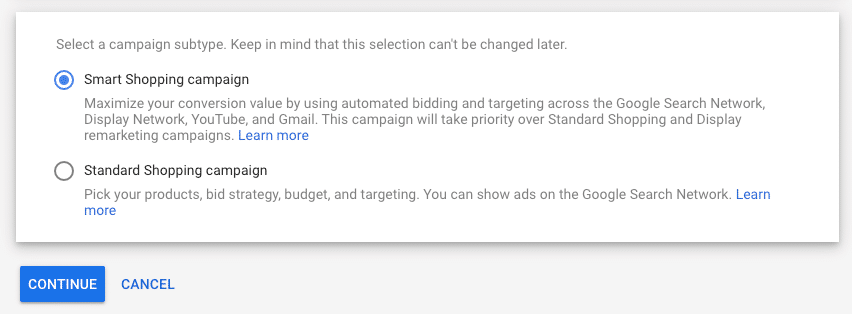
If you pick the Smart Shopping option, in the next step you’ll have to select a budget and bidding strategy.
Starting out, just go with the suggested bid strategy: Maximize conversion value.

Setting a target ROAS might limit your results, we’ll come back to that in the optimization section.
Next you can create product groups. Since you can’t set any max CPC for a product group, splitting them off can be helpful to give you a look into your campaign.
But avoid subdividing your product groups too much, Kirk from ZATO heard from Google that this might hurt performance. Instead, they recommend product groups with min 20 conversions in 15 days. If you don’t have that many, just leave them together.
Another big difference with Standard Shopping Ads is that with Smart campaigns, you need to create an actual ad to show to people.
Smart Shopping Ads
That’s because besides the product listing ads in the search results, Smart Shopping Ads will also run on the Display Network.
So to make sure those look good, you need to provide some additional assets that Google mix and matches to create ads suitable to the placement.
Google calls these Responsive Display Ads. These are a limited version of the ads you can create for a Display campaign:
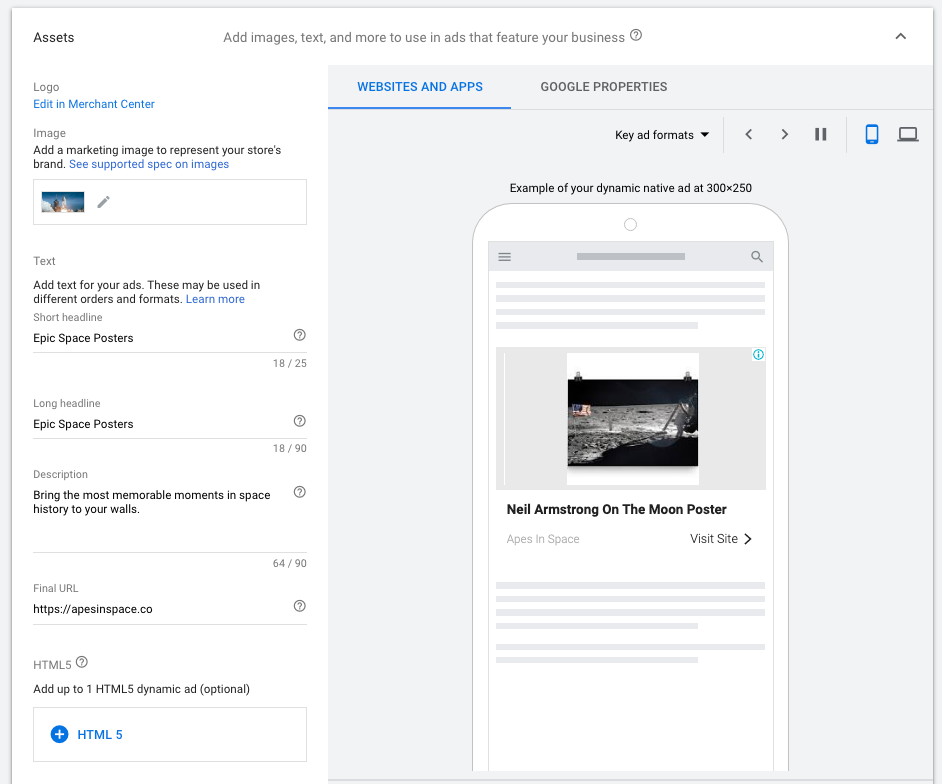
You need to provide an image, a short and Long headline, a description and a final URL.
Your logo is pulled from Google Merchant Center:
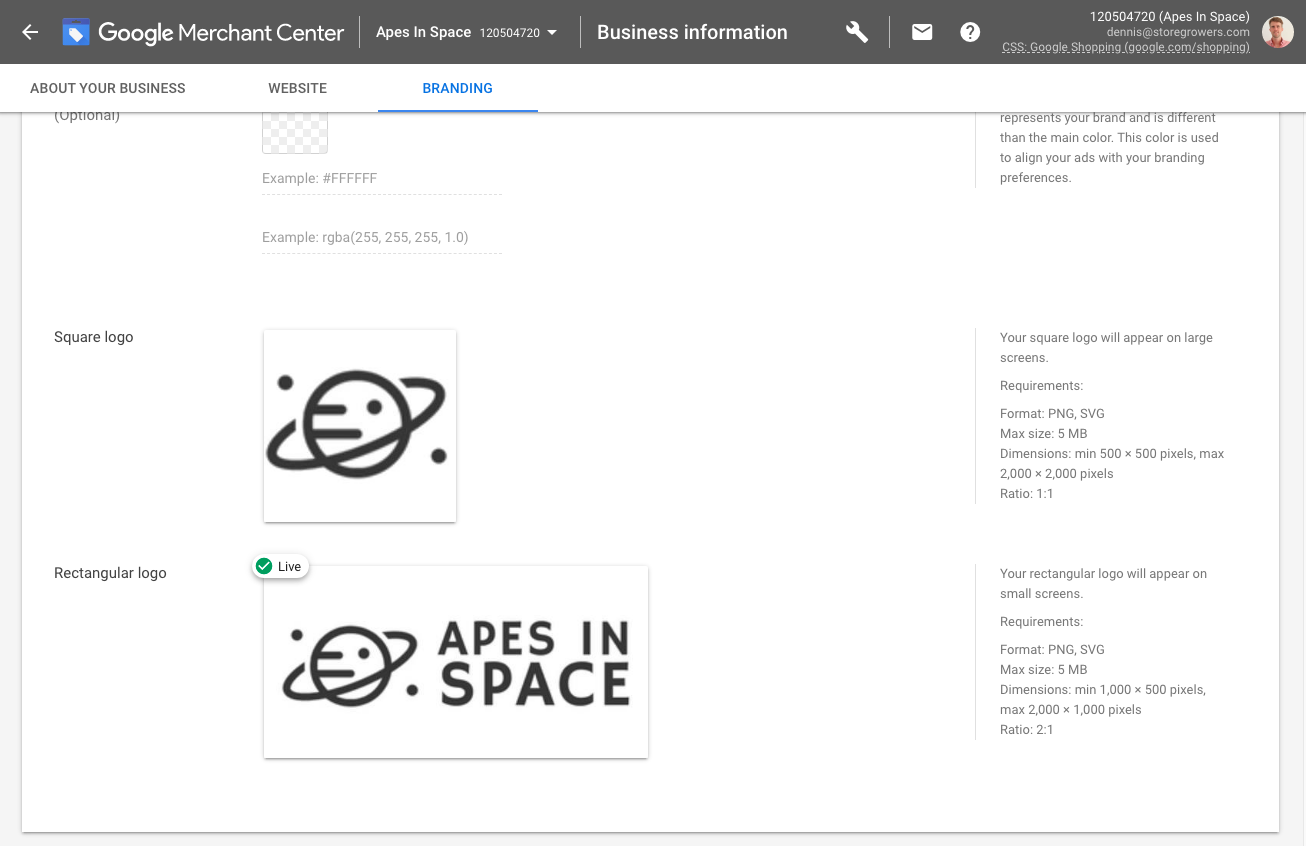
On the right hand side of the screen, you can toggle through all of the different combinations that are possible, booth on desktop and mobile. (There is one ad format missing from the preview, drop by in the comments if you discover which one :P)
Here is an example from my Smart Shopping campaign. This is a YouTube Ad:
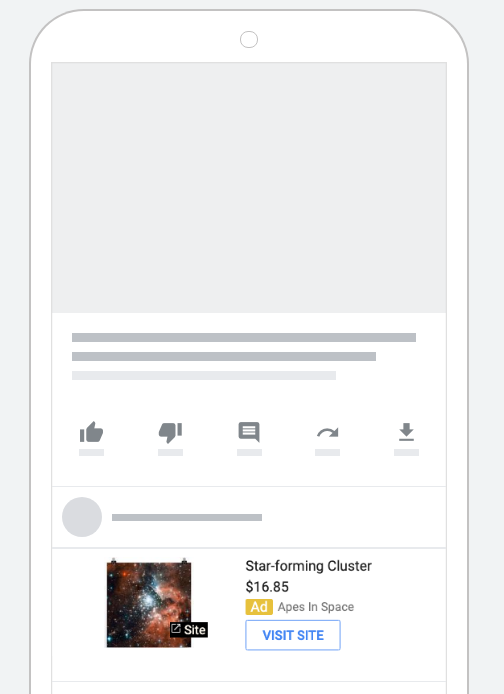
Smart Shopping on Shopify
If you’re using the default Shopify Google Shopping App, you will be pushed into a Smart Shopping campaign automatically.
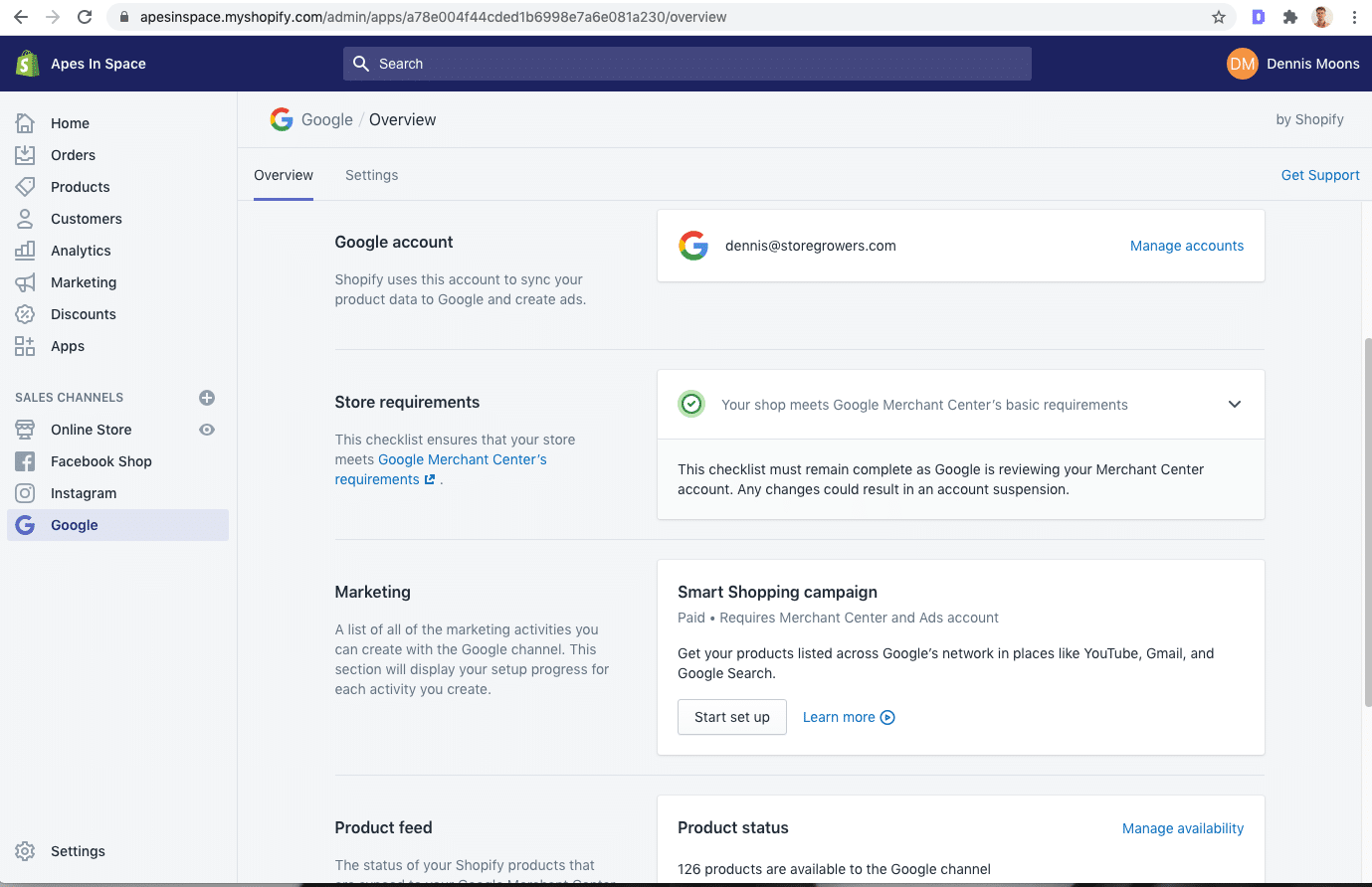
Personally I’m just using the app to get my Google Shopping feed into GMC. Then I just set up the actual campaign in Google Ads. But most new advertisers will follow the tutorial and set up a Smart Shopping campaign unknowingly.
Google Smart Shopping Results
In my experience, the results from Smart Shopping campaigns still lag behind the performance of well-optimized Standard Shopping campaigns.
That last part is important here. Read it again.
As I said before, if you don’t know what you’re doing, the automation in Smart Shopping will reduce the choices you need to make.
In this section, I want to share a couple of case studies where I have seen good results from Smart Shopping campaigns.
(I’ve tried to include recent numbers while still making sure that they aren’t influenced by COVID-19 fluctuations)
Case study 1
The success of this B2B campaign is closely linked with the technical nature of the products.
Most buyers tend to search for the generic category name. That makes it tricky to optimize an existing campaign to surface the right product for the right query.
| Smart Shopping | Standard Shopping | |
| Clicks | 322 | 543 |
| Cost | $126.96 | $456.09 |
| CPC | $0.39 | $0.84 |
| Orders | 13 | 8 |
| Revenue | $667.70 | $233.53 |
| ROAS | 5.3 | 0.5 |
What’s clear from this table is that the Smart Shopping campaigns were overspending. I tried to limit that through various optimizations, but could never reduce the cost while continuing to grow revenue.
Case study 2
This online retailer has a HUGE catalog with products that have small differences. A good comparison would be if I sold 10,000 types of socks for men.
Then each product sold 1-2 units per month. Any analysis on their catalog to split out certain products that did better than others proved trivial.
That made it very hard to allocate the budget accordingly.
| Smart Shopping | Standard Shopping | |
| Clicks | 2,578 | 4210 |
| Cost | $1,527.45 | $1,817.20 |
| CPC | $0.59 | $0.43 |
| Orders | 91 | 40 |
| Revenue | $7,662.34 | $2,115.41* |
| ROAS | 5 | 1.2 |
* This doesn’t include revenue generated by a dedicated dynamic remarketing campaign. That campaign fell from a ROAS of 27 ($27 in revenue for every $1 in cost) before to a ROAS of 19 after. So some sales have moved over the dynamic ads in the Smart campaign, but the overall revenue is still higher compared to before.
Case study 3
Like I said earlier, I run regular tests to keep tabs on how the effectiveness of Smart Shopping is evolving.
This is for my own store, where I ran the same campaign in both 2019 and in 2020:
| 2019 | 2020 | |
| Clicks | 276 | 1,014 |
| Cost | $170.70 | $360.31 |
| CPC | $0.62 | $0.36 |
| Orders | 2 | 15 |
| Revenue | $158.70 | $429.38 |
| ROAS | 0.9 | 1.2 |
Results aren’t stellar (or profitable) yet, but the number of conversions has increased, and that consistency is reassuring (although still unprofitable)
Interestingly the CPC has fallen, suggesting that more clicks have come from the Display network, where the costs per click is lower.
I repeat the same with the other campaigns. Then when I see good results, like the one above, I’ll expand the scope of my tests. I’ll test in a few more accounts and allocate some more budget to it.
Not every account responds the same though. Sometimes I can replicate findings, other times it doesn’t do shit.
Google Smart Shopping optimization
As I said before, the list of tactics available for Smart Shopping optimization is a lot shorter than those available to Standard Shopping campaigns.
When it comes to Smart Shopping campaigns specifically, there are two big levers:
- Budget
- Bidding strategy
I’ll describe the impact of both below. But first there is something else I need to mention.
The Learning Phase
Because of all of the automation, any significant changes you make to the campaign need to be processed by Google.
Google calls this the Learning phase.

Google recommends waiting 14 days for new data to arrive. I’ve found that campaigns stabilize faster.
Budget
Since Smart Shopping is a combination Search AND Display network placements, the inventory of all possible ad placements is a lot bigger.
That means that a change in budget also changes how Google allocates the budget.
A budget of $5 a day might focus on Search results with a bit of remarketing. But if you use a budget of $100 per day, Google might ramp up the amount of Display ads.
Bidding strategy
Smart Shopping uses the Maximize Conversion Value bidding strategy.
And while you can’t change the actual bid strategy, you can play with the details.
By default, there is no target return on ad spend linked to your campaigns. Google will just try to maximize your revenue. Google recommends this option to not limit the scope of its “learning”.
I would also recommend letting the algorithm run like that for a couple of weeks. If you’re pretty edgy that it will waste too much money, consider using a smaller budget or limiting your test to a specific product category.
After a couple of weeks, you should have some idea what to expect performance-wise. You’ll also know if the ROAS is within an acceptable range. If it is not, you can start to set tighter guard rails.
If you achieved for example a ROAS of 253% during your first test, you could set a target ROAS of 200%.

Picking a target that’s lower than your baseline will always work, but a sharper one can cause problems. If I set a target of 300% in the example above, it could very well be that Google stops showing my ads because it can’t make 300% work.
Smarter With Your Ads
While I’m still not a big fan of Smart Shopping, I’m spending more time experimenting with this campaign subtype.
I hope that this article helped you to understand a bit better on what Smart Shopping actually entails, and how you can leverage it for your store.
Hungry for more?
Grab our list with all the Google Shopping optimization tactics that I use to get results for my clients right now. Get access now!
The post The Google Smart Shopping Dilemma: Control Vs Automation appeared first on Store Growers.
 from Google Ads Tips & Tricks That Actually Make Money – Store Growers https://ift.tt/2ZogfN8
from Google Ads Tips & Tricks That Actually Make Money – Store Growers https://ift.tt/2ZogfN8 via IFTTT
via IFTTT

No comments:
Post a Comment